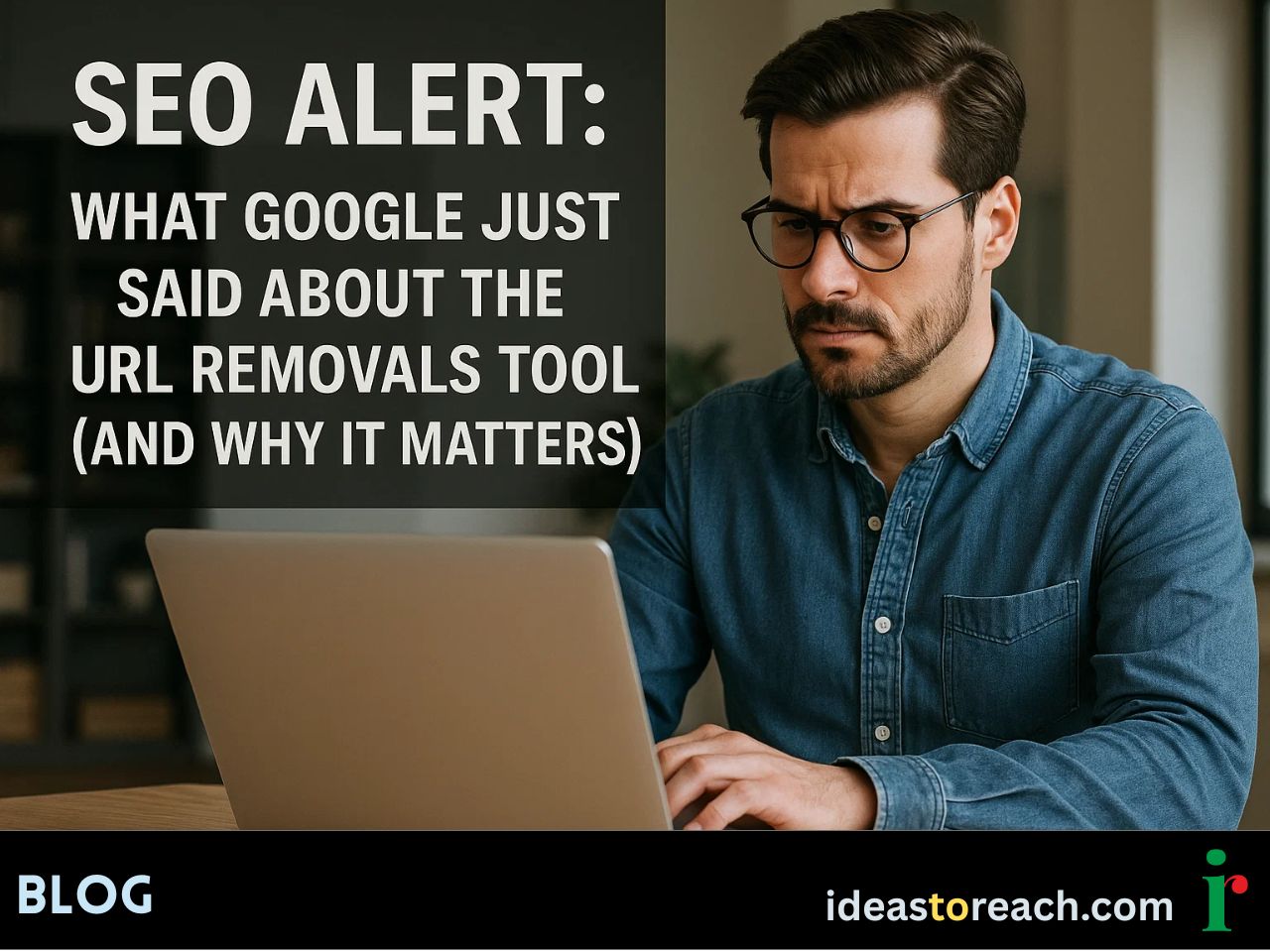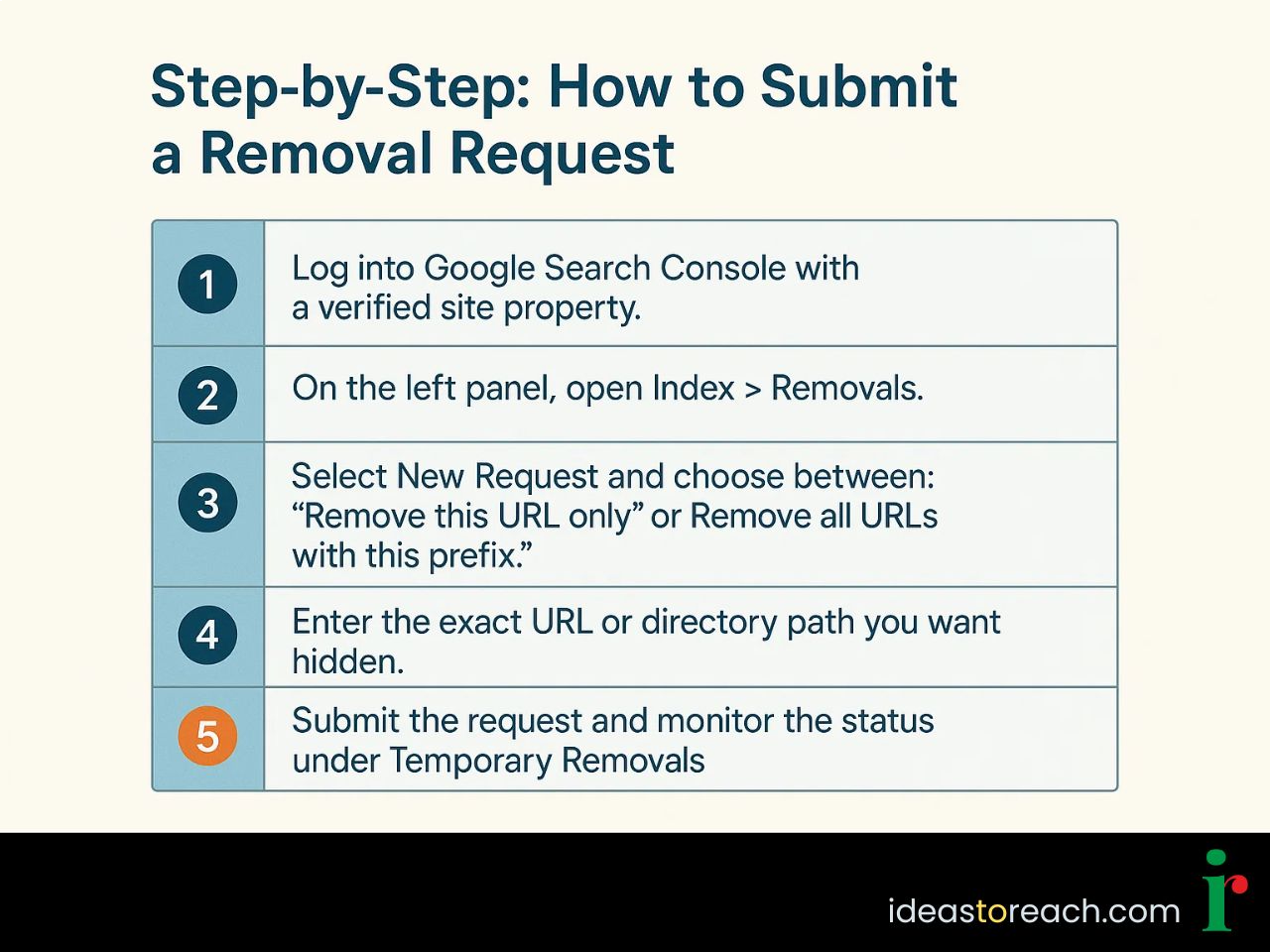
In 2025, Google issued a subtle but important reminder to SEOs and website owners which the Google URL removal tool is not a permanent delete button. For many Indian businesses, that clarification went unnoticed. At Ideas To Reach, we understand the importance of this for your search performance, crawl management, and online reputation.
Whether you’re an SEO manager, a site owner, or a business leader aiming to protect your brand’s visibility, here’s everything you need to know about how to use the URL removals tool in Google Search Console, when to use it, and what pitfalls to avoid.
Recently, Google Search Advocate John Mueller restated that using the URL removals tool in Google Search Console only hides a page from Search Engine Results Pages (SERPs) for about six months. It doesn’t delete the URL from Google’s index. After that period, the content may reappear if permanent actions such as noindex directive, robots meta tag, or HTTP 404/410 status codes aren’t applied.
This reminder reinforces why SEOs should pair temporary removals with long‑term strategies. At Ideas To Reach, we map such updates into a long-term SEO success roadmap that ensures every URL serves a clear purpose and supports sustained ranking growth.
The URL Removals tool is part of Google’s Removals and SafeSearch reports. As a verified property owner in Google Search Console, you can submit requests to remove content temporarily, clear cached pages, or monitor outdated information.
There are two key removal options:
Temporarily Remove URL. This hides a page from search results for about six months and clears cached data.
Clear Cached URL. It helps to remove the stored page description and cache until Google re‑crawls the page.
You can also use the Outdated Content feature when snippets display old or sensitive data, or SafeSearch filtering requests to hide adult or explicit content.These options don't delete content. But they only control visibility. By following up with lasting technical fixes, such as a noindex tag or returning 410 status codes, you maintain accurate index coverage and prevent outdated pages from reappearing.
For SEOs in India wondering how to use the URL Removals tool in Google Search Console, here’s a smooth, quick process you can follow:
Log into Google Search Console with a verified site property.
On the left panel, open Index > Removals.
Select New Request and choose between:
“Remove this URL only” or
“Remove all URLs with this prefix.”
Enter the exact URL or directory path you want hidden.
Submit the request and monitor the status under Temporary Removals.
This process helps temporarily remove URL Google Search results while giving you time to apply permanent corrective actions, especially when working on sensitive data or major redesigns.

The Google Search Console removals report shows several legitimate reasons why Indian SEOs depend on this feature. It’s beneficial in situations such as:
Removing pages containing sensitive or confidential user information.
Hiding duplicate content created during migration or testing phases.
Temporarily removing outdated product listings or discontinued services.
Managing legal or compliance content issues.
Controlling brand reputation risks from mistakenly published pages.
However, SEOs should remember that this tool won't prevent crawling. You still need to apply the noindex directive or update server responses for full de‑indexation.
When planning a large‑scale cleanup or rebranding, following a structured approach based on SEO best practices in India ensures every step strengthens long‑term visibility rather than causing ranking drops.
The Google URL Removals tool and the noindex tag serve different but complementary SEO functions. The Google URL Removals tool, found within Google Search Console, provides a quick, temporary way to hide URLs from appearing in search results for about six months. It’s ideal for sensitive content, urgent removals, or outdated information that needs to be hidden immediately without changing the site code. However, it doesn’t delete the page as it only hides it temporarily until Google re‑crawls your site.
Meanwhile, the noindex tag ensures a permanent exclusion from Google’s search index. By adding in a webpage’s
section, site owners tell search engines not to display that page in search results, even though it can still be crawled. As we often tell our clients when helping them create a clear SEO roadmap, using both in sequence delivers the best outcome as instant concealment through the removals tool and lasting de‑indexing stability with the noindex tag.Google’s 2025 communication was a wake‑up call to the global SEO community. It’s not about whether you’ll use the tool as it’s how responsibly you use it. Indian websites with frequent product updates, multiple subdomains, or CMS‑based blogs often need temporary removals to maintain freshness.
But a mature SEO strategy should integrate permanent fixes into every campaign. For example:
Use the Index Coverage report to detect content still indexed after deletion.
Replace old links in sitemaps and internal pages.
Verify content status using site verification tools.
Adopting this proactive model transforms URL management from reactive clean‑ups into structured improvements that boost crawl efficiency and maintain domain trust.
Our team consistently uses insights from Google’s evolving algorithms to help brands overcome the latest ranking challenges in Google Search and keep their sites free from errors or wasteful crawls.
If you manage older domains with thousands of legacy posts, you may find your search results cluttered with unused URLs. For such cases, a planned method of using the Google Search Console removal request for old URLs works best.
Follow these steps:
Identify old or low-performing URLs through analytics or the Index Coverage report.
Submit a temporary removal for immediate action.
Add noindex tags or set 404/410 responses for outdated links.
Confirm updates through new crawl reports in Google Search Console.
This process ensures smoother reindexing of your current content and supports higher engagement metrics.
We’ve seen clients recover significant organic traffic simply by removing outdated clutter. In doing so, they made room for new, relevant content that ranks faster and performs better.
Despite being temporary, the Google URL Removals tool remains an essential safety mechanism in modern SEO. It lets businesses act quickly to protect user data, prevent misinformation, and safeguard their reputation. And everything without waiting for Google’s next crawl cycle.
At Ideas To Reach, we integrate such corrective measures with broader optimisation projects. Our systems help clients merge tactical tools with growth strategies, ensuring sustainable trust and ranking stability.
Continuously applying lessons from Google’s E-E-A-T signals explained strengthens content quality and credibility in an AI‑driven ranking environment.
If your business needs expert guidance to hire a trusted SEO company in Chennai for precision work on site crawl management. In that case, our specialists are ready to build your next compliant, data‑driven plan.
To future‑proof your content strategy, explore our insights on:
Strengthening your digital foundation for 2026 using our long-term SEO success roadmap.
Understanding how to turn SEO rankings into real business revenue.
Adopting image SEO best practices from Google to maintain brand consistency across visual search.
Each article offers expert‑backed strategies built on extensive experience in the Indian and international markets.
To future-proof your SEO strategy, embracing the latest insights and adapting to evolving algorithms is essential. Exploring expert-backed resources, such as our long-term SEO success roadmap and techniques to convert rankings into real business revenue, empowers you to stay ahead in the competitive digital landscape.
Additionally, adopting Google’s image SEO best practices ensures consistent brand visibility across all search formats. Implementing these strategies together helps your online presence remain strong, relevant, and aligned with both user intent and search engine expectations in 2026 and beyond.
The Google URL removals tool in Google Search Console allows verified website owners to hide webpages temporarily from search results. It’s ideal for quick fixes that take immediate effect and last about six months before expiring automatically.
Whenever urgent or sensitive content is live and needs to be hidden instantly, including confidential pages, duplicate URLs, or compliance‑related content.
No. It only hides content for roughly six months. Permanent deletion requires other SEO actions such as a noindex tag, removing content, or using HTTP 410 codes.
Avoid depending solely on temporary removals. They do not stop crawling or reindexing by Google. Combine removal requests with proper canonicalisation and server‑level clean‑ups for best results.